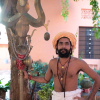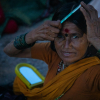The interview tries to unravel the proceedings of the Madai and its significance, and to find out who the agents involved in the organization of this event are. This interaction interestingly highlights a distinctive feature of Madais celebrated north of Bastar. In Dhamtari (north of Bastar), Madais are seen to extend beyond sub-communities; it caters to the broader adivasi life and not merely to the adivasis of the Gond community. Adivasi life is not only restricted to that of Gond community, but it is a broader understanding of the lifestyle of communities, such as the Routh, Tamrakar, Gadha etc.
Swarnima Kriti (S.K.): Sir, we are here to talk to you about Madais. We would like to know what exactly is the Madai and what is the importance of this occasion in Chhattisgarh?
Govardhan Mandavi (G.M.): Madais are celebrated across the state of Chhattisgarh. It is an ancient tradition, where people of a village hosting the Madai send invitations to the neighbouring villages. Invitations are sent in the form of one supari (areca nut) and some rice grains for the baiga of the other villages. They are requested to be a part of the Madai being organized. Gods and goddesses of the neighbouring villages become a part of the Madai as the people of these villages also participate in the festival. This is an occasion when primarily the gods and goddesses of various villages are brought together. It is also a festival when people of the village meet (their friends and family). During Madais, several kinds of shops and stall that sell different kinds of commodities are set up. These shops are well decorated and attract a lot of attention as do the actual celebrations of the Madai.
S.K.: Sir, you have very nicely explained the importance of the Madai, but, we would also like to understand how is it organised?
G.M.: The major crop in Chhattisgarh is paddy (rice), and paddy harvestation is usually complete by December or January. After the harvest, people in the village have the tradition of celebrating Madais every year. It starts being celebrated from the month of Mang/Magha (January-February). If the people in the village want to celebrate the Madai, they first organize a meeting where all the people from the village are present. The discussion is about the organization of the Madai that requires monetary assistance. Thus, they discuss and plan how the money would be collected. An amount for collection, which would be used to organize the Madai, is settled in the meeting. The primary cost while organizing a Madai is for hosting the neighbouring gods and goddesses who come to the village as invitees. They are gifted with fruits, flowers, lemon; everything required for worshiping them is to be bought by the money being collected. At night, a cultural programme is organized which costs the village a substantial sum of money. This is how villages prepare for Madais.
S.K.: Who plays the major role in the festival of the Madai?
G.M.: The gram pramukh (leader of the village) plays a major role in the festival of the Madai. So do the worshippers of the gods and goddesses; the priests are called baiga and gaita. The baiga plays an important role in welcoming the neighbouring gods and goddesses during a Madai. .
S.K: Who are baigas?
G.M.: Baigas are people who worship the gods and goddesses. They perform rituals and conduct the process of worshiping the deities. Each village has a baiga. They are people who have tantra mantra vidya (knowledge of different forms of black magic) etc. Only those who have this knowledge can become a baiga. Such knowledge is generally passed from one generation to another. The son of a baiga shall become the next baiga of the village. Traditionally,baigas groom their newer generations with this knowledge.
S.K.: What is the contribution of the different communities (village community, Gond community, Yadav community etc.) and what is the kind of contribution they make?
G.M.: The Madai is a programme organized by the communities and hence they play a very important role. The process of organization and planning of labour, as also the fund collection, is all done by the community. This festival is the community’s responsibility. The people of the community make the festival possible by participating in it.
S.K.: Does the village as a community enable the planning of the Madai or do the different sub-communities i.e. the Gond, the Yadav, etc. also contribute in some manner?
G.M.: This is not a festival of any ‘one’ caste. All the different castes come together to organize this event. Each caste thus, has separate responsibilities. The structure of the society is such that the twelve different castes stand together. Each caste plays a specific role in the Madai, For example, the musical instruments used during a Madai are played only by the Gongs. The Rouths get ready, dress up and welcome the gods and goddesses, people from the Marar community make garlands for the deities, the Lohars too have a separate role to play. People from all the sub communities help in following this tradition.
S.K.: How does the state be of help during the Madai?
G.M.: The village comes under a panchayat, thus, if the village is organizing a Madai then the panchayat helps. The sarpanch helps with some extra contribution. The panchayat helps in cleaning the place where the Madai takes place, makes arrangements for drinking water, tents, and also makes sitting arrangements. At the level of the nagar panchayat or the city council, they help in a similar manner. In case of a grand gathering, they help with arrangements of sitting, tents, drinking water and security. They also help by contributing for the Madai though mostly at individual levels in a personal capacity.
This content has been created as part of a project commissioned by the Directorate of Cultural and Archaeology, Government of Chhattisgarh, to document the cultural and natural heritage of the state of Chhattisgarh.













